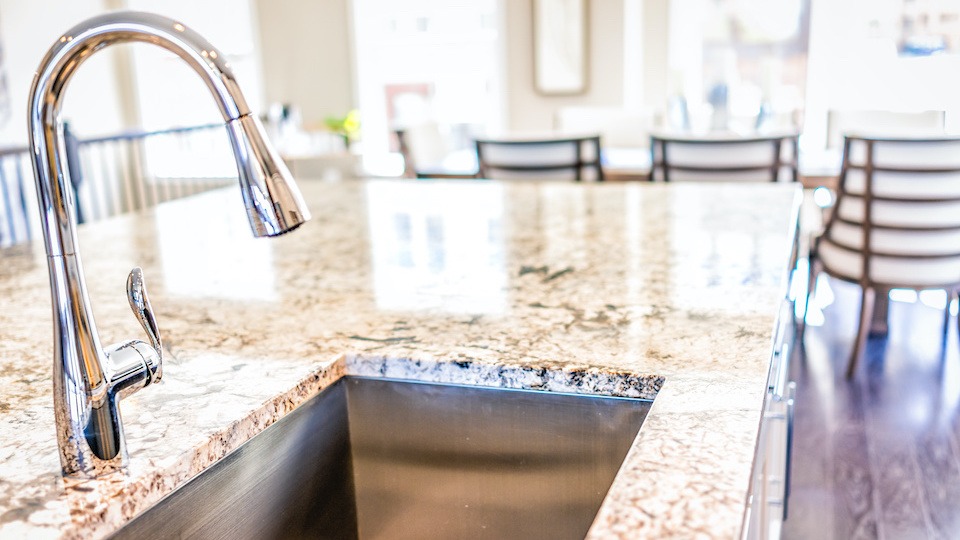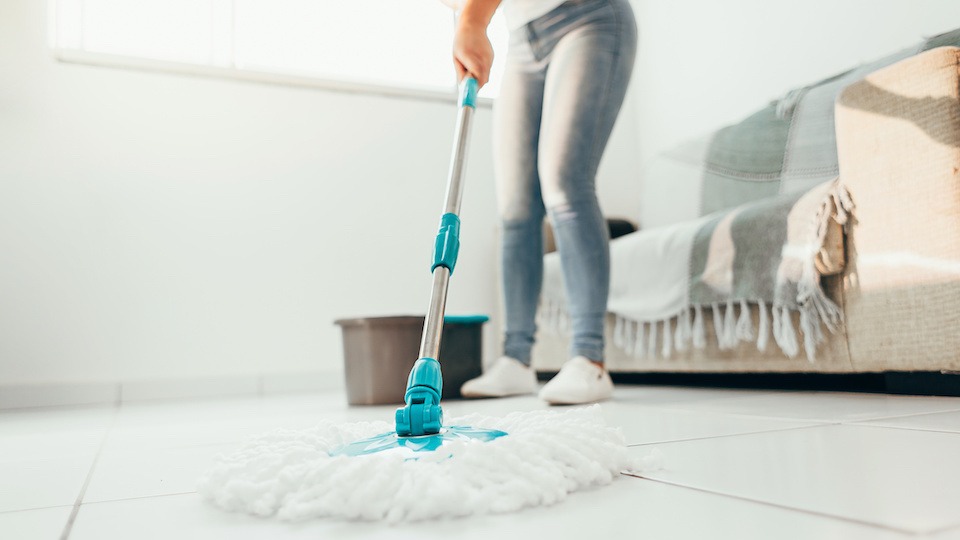You launder your clothes, wash the dishes, and clean the toilet…but do you pay attention to these “forgotten” areas of the home that can harbor dangerous bacteria, viruses, and mold? Here are the spots that tend to fly under the cleaning radar, plus an easy homemade disinfectant spray recipe to remedy the problem.
The kitchen sink
The kitchen sink, and more specifically, the cleaning sponge which often rests inside, is probably the worst offender for harboring dangerous bacteria in your home. Food particles from plates left to soak or rinsed from dishes on their way to the dishwasher can serve as a breeding ground for illness-causing bacteria, including E. coli and salmonella. They can get on your hands or spread to foods. The sponge is even worse. Not only is this warm, moist and porous surface grimier than a public toilet, but it also acts as a vehicle for spreading germs from surface to surface.
A 2012 study found that the dish sponge is the worst “microbial hotspot” in the entire home. The main types of bacteria found in kitchen areas are coliforms, which include E. coli. E. coli bacteria are almost exclusively of fecal origin, so when they are found, it serves as a confirmation of fecal contamination. Most strains of E. coli are harmless, but some can cause serious illness. Infection symptoms and signs include bloody diarrhea, stomach cramps, vomiting, and occasionally, fever. The bacteria can also cause pneumonia, other respiratory illnesses, and urinary tract infections.
The best way to prevent this bacterial free-for-all in your kitchen is to replace the sponge with microfiber cloths that get laundered daily. Use a hot wash with disinfectant soap to ensure they’re thoroughly cleansed. Another option is to use a stiff-bristled dish brush instead of a sponge. Soak it in disinfectant and put it through the dishwasher’s hot wash regularly.
Toothbrush holder
The same study reported that the toothbrush holder is the second most infectious place in the home. It has been found that toothbrushes can play a significant role in disease transmission and increase the risk of infection since they can serve as a reservoir for microorganisms. Toothbrushes from both healthy patients and patients with oral disease contained potentially pathogenic bacteria and viruses such as Staphylococcus aureus, E. coli, Pseudomonas, and herpes simplex virus. Plus, if they’re stored near the toilet, they’ll collect aerosolized fecal bacteria each time you flush. The transmission of bacteria works both ways, with the toothbrush getting more and more contaminated with continued visits to the mouth, and also harboring enough pathogens to inoculate the mouth of the user with disease.
Rinsing with tap water was found to do little to reduce pathogens, and toothpaste and mouthwash were only partially effective; therefore, the best way to reduce the bacteria living on your toothbrush is to soak it in disinfectant overnight. Another study recommended: “Monthly replacement or disinfection of the toothbrush can reduce the risk of bacterial transmission/translocation and thus diminish the incidence of biofilm-associated oral diseases.”
Cutting board
Cracks and crevices caused by wear and deep knife cuts make the cutting board a damp, dark, safe harbor for bacterial growth.
The fix: If you’re using a wooden board, wash well with steaming hot water and soap before allowing to dry thoroughly. If using a plastic board, run it through the dishwasher and use separate ones for produce and meat/poultry.
Other options to disinfect a cutting board include:
- Spraying it with straight 5 percent vinegar, and letting it sit overnight
- Microwaving it on high for 30 seconds
- Swabbing it with alcohol
Spatulas
Spatulas, especially the rubber variety, are full of nooks and crannies that were found to hide E. coli, yeast, and mold by an International Household Germ Study. If your spatula is made from two parts, make sure to separate them when washing. Generally, metal models are better as they aren’t as vulnerable to collecting germs.
Shower curtain
Almost perpetually damp, shower curtains are the ideal breeding ground for mold, a serious hidden hazard in your home. A study found that your shower curtain can hold up to 60 times more bacteria than your toilet seat. To keep it as clean as possible, you can spray your shower curtain with distilled white vinegar after showering to help kill any mold or mildew that has started to form. Remove the curtain periodically and give it an overnight soak and hot wash, then dry thoroughly.
Dishwasher
The very appliance that cleans your dirty plates is also a germ danger zone. The bottom of your dishwasher collects old food and grease, so it’s important to wash any of the removable parts as frequently as you can. It’s also a good idea to fill a dishwasher-safe mug with white vinegar and leave it on the top rack during an empty cycle, which will loosen up any residue and wash it away.
Pet beds & toys
If you have a pet in your home, you probably need to know that pet dishes were found to be the fourth germiest place in the homes analyzed by the Germ Study. Pet toys were found to be a source of coliform bacteria (including Staph bacteria), yeast, and mold in many homes. Encourage everyone in your household to wash their hands after playing with household pets and especially before eating.
Pet dishes should be washed daily, either in a sanitizing dishwasher or scrubbed by hand with hot soapy water, then rinsed. Hard toys can be cleaned with hot soapy water, disinfected and thoroughly rinsed to remove any residue, then allowed to air dry. Soft toys can be washed with other laundry on the washer’s sanitizing cycle. Wash monthly or as often as needed.
Blender gasket
According to the Household Germ Study, Salmonella, E. coli, yeast, and mold were all found on blender gaskets. In fact, they ranked as the third germiest item in the homes which were tested.
To clean, unplug the blender and remove the blender jar from the base. Completely disassemble the jar, removing the blade and gasket at the bottom. If they are dishwasher safe, place all pieces in the dishwasher after each use. If hand washing, wash the gasket, blade assembly, jar, and lid thoroughly in hot soapy water, rinse and dry before re-assembling. Perform this cleaning procedure after each use.
TV remote
What do you do when you’re sick? You jump in bed with the TV remote. Clean remotes, controllers, and other touch-heavy electronics regularly with a disinfectant to banish flu and cold viruses.
Salt & pepper shakers
Salt and pepper shakers are constantly picked up throughout the day by any number of family members and rarely get the cleaning that they need. A simple wipe over with disinfectant at the end of the day will do the trick.
How to deep clean germs naturally
Try making this natural disinfectant spray to clean and freshen your home. It’s effective on hard surfaces like countertops and doorknobs, and also works great as a fabric refresher. Remember to spot-test items first to ensure color safety.
First, you will need to choose your essential oils. Extensive research has highlighted the natural disinfecting properties of essential oils.
- In this study, thyme, oregano, mint, cinnamon, and clove were found to have the strongest antibacterial and antifungal properties
- Another study reported that cinnamon, clove, geranium, lemon, lime, orange and rosemary oils were found to be most effective at inhibiting bacterial growth
- Additional research confirmed that cinnamon, clove, thyme, and geranium were found to be the most comprehensively effective against the greatest number of bacterial species
The other ingredients you will need are:
- Alcohol with at least 70 percent strength
- 1/2 teaspoon hydrogen peroxide
- 16 oz glass spray bottle
You can use either ethanol (in the alcohol that you drink) or isopropyl alcohol (commonly called rubbing alcohol). Both ethanol and isopropyl alcohol are effective disinfectants. The key is to use a product that is at least 70 percent alcohol. A study published in the Journal of Hospital Infection suggested that viruses could be “efficiently inactivated” with disinfectants that contain 70-90 percent alcohol and 0.5 percent hydrogen peroxide.
How To Make Essential Oil Disinfectant Spray
- Fill the glass spray bottle most of the way full with high-proof alcohol.
- Add 1/2 teaspoon hydrogen peroxide.
- Add 75 drops of essential oils of your choice.
- Put on spray top and shake to mix well
- Be sure to label the bottle and keep away from pets and children.
To use, shake first, then either spray onto a cloth and wipe the surface, or for heavier disinfection, wet surface well, leave wet for at least one minute, and wipe or allow to air dry.
Keep in mind that we live with billions of bacteria on, in, and around our bodies every single day. Many of them are even vital for our survival. There is no need to be overly concerned about excessive sanitizing, but giving extra attention to the items highlighted in this article will help keep your home fresh, happy, and healthy.
-The UpWellness Team








